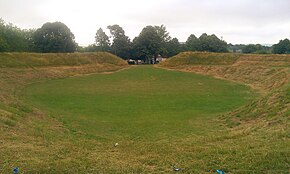Maumbury Rings

Interior of Maumbury Rings viewed from southern end
|
|
| Location | Dorchester, Dorset |
|---|---|
| Coordinates | 50°42′28″N 2°26′25″W / 50.70790°N 2.44039°W |
| Type | Henge |
| History | |
| Periods | Neolithic, with later Roman and Civil War modifications |
Maumbury Rings is a Neolithic henge in the south of Dorchester town in Dorset, England (grid reference SY690899). It is a large circular earthwork, 85 metres in diameter, with a single bank and an entrance to the north east. It was modified during the Roman period when it was adapted for use as an amphitheatre, and the site was remodelled again during the English Civil War when it was used as an artillery fort guarding the southern approach to Dorchester. The monument is now a public open space, and used for open-air concerts, festivals and re-enactments.
Maumbury Rings is a roughly circular henge situated close to the centre of Dorchester. It has an internal diameter of around 50 metres. The bank has an average width of 4 metres, and is around 5.6 metres high internally and 4.0 metres high externally. A bulge in the earthworks to the southwest marks the site of a gun emplacement built during the English Civil War, and the inner side of the bank was terraced on the east and west sides at this time. There is no trace of the original internal ditch.
Maumbury Rings were excavated by Harold St George Gray from 1908–1913. The excavations showed that the site originated in the later Neolithic period. The excavations revealed an internal ditch which comprised a series of deep shafts cut into the chalk. These number up to 45, and were up to 11 metres deep. Eight shafts were fully excavated. They contained various deposits including antler, animal and human bone, flints and carved chalk. A single Grooved ware pottery sherd was recovered from one pit, and a later Beaker sherd was recovered from the fill of another pit. The henge had a single entrance on the northeast side. It is recorded that a large stone was discovered during cultivation in 1849 to the west of the entrance, but it was reburied and has not been seen since.
...
Wikipedia

